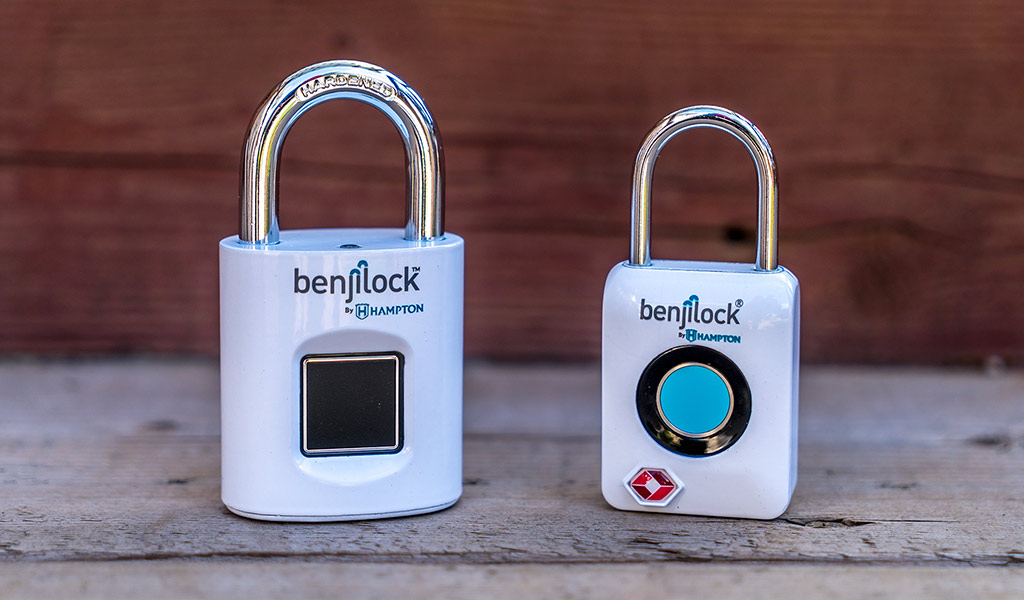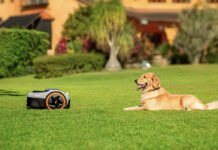
Smart locks are a common gadget to find these days, and one that stands out for its consistency and protection is the BenjiLock by Hampton.
Padlocks haven’t changed for a long time, with a history that dates back to the Roman Empire. The concept has remained more or less intact—a semi-circle ring that locks into a base you can unlock with a key. The BenjiLock uses a fingerprint to do the same thing, adding extra convenience to an age-old tradition.
Design
This is essentially a hybrid lock. It has all the trappings of a padlock, but with electronic components centred on the fingerprint sensor in front. It also comes in two sizes with colour variants between them.
The larger 43mm model is the most versatile in that you would use it anywhere you use a standard lock. It weighs 281g, so does have some heft to it, courtesy of die-cast zinc and a hardened chrome-plated steel shackle. It has a sizeable fingerprint sensor in the middle with tiny LEDs that light up around it, along with a physical button and keyhole at the bottom.
On the inside is a rechargeable 110mAh lithium battery that can last up to 12 months per charge. That range will vary by conditions, meaning the colder or hotter the weather, the more likely the battery will need a recharge sooner. Still, it should take months before that happens. While the lock can store up to 10 different fingerprints, it does come with two physical keys to ensure you can still unlock it the old-fashioned way.
The smaller of the two locks is the TSA Travel/Luggage Fingerprint Padlock. It’s the same idea, though more diminutive at 33mm and 90g, yet built primarily for travel. Unlike its larger sibling, it doesn’t have physical keys, and stores up to five fingerprints, rather than 10. The TSA designation makes it play nice with airport security at U.S. airports, though it really is aimed at global travel.
That explains why there is a keyhole at the bottom, but no actual keys in the package. It’s a Travel Sentry Lock security can open without ruining the lock. In lieu of the physical keys, this one does offer physical combinations through the numerical buttons in the back.

Setup
Each lock comes with a one-page set of instructions on how to set it up with a fingerprint. It also indicates how to add other users and their fingerprints, or to delete them and master reset the lock. The steps are laid out one-by-one, though they may not always feel straightforward because of the required sequence.
I’ve had plenty of experience with BenjiLock, and one of the missteps I made (again) was at the point I needed to press the button at the bottom. A minor mistake, mind you, since the lock always resets back to its initial state in case the setup fails, but one that you might also encounter when putting in additional fingerprints. If you can find a video online to run through the steps, it may work out better for you.
The best way to assess progress is to note what the LED lights are doing. The good news is once you’ve done that the first time, it should be easier to add extra fingerprints. The Travel Padlock has a slightly different process, but it’s a similar number of steps. When finished, either lock works smoothly thereafter.

Using the BenjiLock
An electronic padlock is unlike typical gadgets. It has a singular focus and is passive in nature, but it does the job. It doesn’t work with a dedicated app, nor has Bluetooth or Wi-Fi, so has no active feature that way. Set it up and lock it, and that’s about it.
One thing that is worth noting, particularly in Canada, is that it works outdoors. BenjiLock claims a range between -20 to 65-degrees Celsius, covering most weather variances in the country, though not the really cold days. Thankfully, the physical key can step in those cases. That’s not the case with the Travel Padlock, which is not made for outdoor use, and may fail if exposed to the elements.
The fingerprint sensor is also pretty specific. Half the time, I had to place my thumb on it twice to register and unlock. It didn’t bother me all that much because I got used to it over time. Since it’s a lock, I didn’t interact with it all that often, but when I did, it was a consistent experience. One of the main things I had to keep in mind was where to put the physical keys. In my previous model, I had misplaced them once, and it may be something to remember in your case.
The company says the lock isn’t easy to pick because of the spool pins inside. I never tested that out, so don’t know for sure. On the electronic side, it’s hard to spoof a fingerprint because the matte surface doesn’t retain remnants of the print. Alternatively, using plastic to spoof a print also didn’t work when I tried it.
Final thoughts
No matter what kind of gadgetry goes into a lock, it’s pointless if it doesn’t stay locked. That’s not a problem with these models. It just depends on how well it reads your fingerprint on a consistent basis. Despite what might be limited interaction with the lock, your patience may wear thin quickly, which is why I think this is a more personalized device beyond a fingerprint. Personally, I like the idea of not having to carry keys all the time, and that’s something these locks deliver.
The larger of the two locks is good for most locking situations, be it a gate, locker, bag, box, or whatever else you can think of. The smaller one is aimed at travel, but you can use it for anything relative to its size.
The BenjiLock by Hampton 43mm and Travel Padlock are available now.



